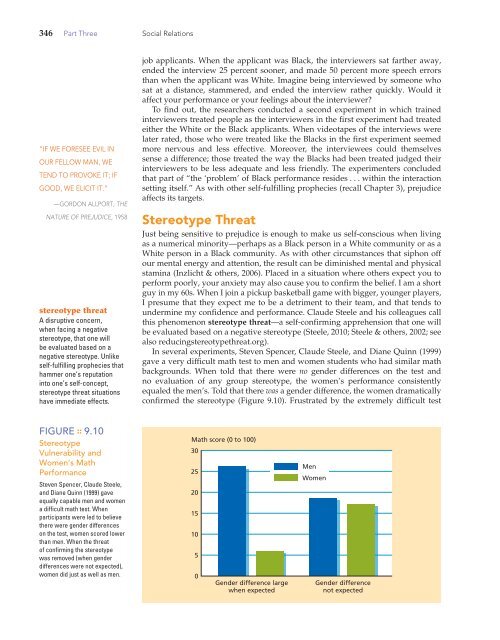Chapter 9: Prejudice: Disliking Others (2947.0K) - Bad Request
Chapter 9: Prejudice: Disliking Others (2947.0K) - Bad Request
Chapter 9: Prejudice: Disliking Others (2947.0K) - Bad Request
Create successful ePaper yourself
Turn your PDF publications into a flip-book with our unique Google optimized e-Paper software.
346 Part Three Social Relations<br />
“IF WE FORESEE EVIL IN<br />
OUR FELLOW MAN, WE<br />
TEND TO PROVOKE IT; IF<br />
GOOD, WE ELICIT IT.”<br />
—GORDON ALLPORT, THE<br />
NATURE OF PREJUDICE, 1958<br />
stereotype threat<br />
A disruptive concern,<br />
when facing a negative<br />
stereotype, that one will<br />
be evaluated based on a<br />
negative stereotype. Unlike<br />
self-fulfilling prophecies that<br />
hammer one’s reputation<br />
into one’s self-concept,<br />
stereotype threat situations<br />
have immediate effects.<br />
FIGURE :: 9.10<br />
Stereotype<br />
Vulnerability and<br />
Women’s Math<br />
Performance<br />
Steven Spencer, Claude Steele,<br />
and Diane Quinn (1999) gave<br />
equally capable men and women<br />
a difficult math test. When<br />
participants were led to believe<br />
there were gender differences<br />
on the test, women scored lower<br />
than men. When the threat<br />
of confirming the stereotype<br />
was removed (when gender<br />
differences were not expected),<br />
women did just as well as men.<br />
job applicants. When the applicant was Black, the interviewers sat farther away,<br />
ended the interview 25 percent sooner, and made 50 percent more speech errors<br />
than when the applicant was White. Imagine being interviewed by someone who<br />
sat at a distance, stammered, and ended the interview rather quickly. Would it<br />
affect your performance or your feelings about the interviewer?<br />
To find out, the researchers conducted a second experiment in which trained<br />
interviewers treated people as the interviewers in the first experiment had treated<br />
either the White or the Black applicants. When videotapes of the interviews were<br />
later rated, those who were treated like the Blacks in the first experiment seemed<br />
more nervous and less effective. Moreover, the interviewees could themselves<br />
sense a difference; those treated the way the Blacks had been treated judged their<br />
interviewers to be less adequate and less friendly. The experimenters concluded<br />
that part of “the ‘problem’ of Black performance resides . . . within the interaction<br />
setting itself.” As with other self-fulfilling prophecies (recall <strong>Chapter</strong> 3), prejudice<br />
affects its targets.<br />
Stereotype Threat<br />
Just being sensitive to prejudice is enough to make us self-conscious when living<br />
as a numerical minority—perhaps as a Black person in a White community or as a<br />
White person in a Black community. As with other circumstances that siphon off<br />
our mental energy and attention, the result can be diminished mental and physical<br />
stamina (Inzlicht & others, 2006). Placed in a situation where others expect you to<br />
perform poorly, your anxiety may also cause you to confirm the belief. I am a short<br />
guy in my 60s. When I join a pickup basketball game with bigger, younger players,<br />
I presume that they expect me to be a detriment to their team, and that tends to<br />
undermine my confidence and performance. Claude Steele and his colleagues call<br />
this phenomenon stereotype threat —a self-confirming apprehension that one will<br />
be evaluated based on a negative stereotype (Steele, 2010; Steele & others, 2002; see<br />
also reducingstereotypethreat.org ).<br />
In several experiments, Steven Spencer, Claude Steele, and Diane Quinn (1999)<br />
gave a very difficult math test to men and women students who had similar math<br />
backgrounds. When told that there were no gender differences on the test and<br />
no evaluation of any group stereotype, the women’s performance consistently<br />
equaled the men’s. Told that there was a gender difference, the women dramatically<br />
confirmed the stereotype ( Figure 9.10 ). Frustrated by the extremely difficult test<br />
Math score (0 to 100)<br />
30<br />
25<br />
20<br />
15<br />
10<br />
5<br />
0<br />
Gender difference large<br />
when expected<br />
Men<br />
Women<br />
Gender difference<br />
not expected

















